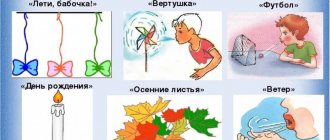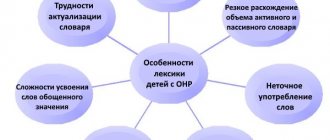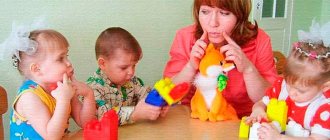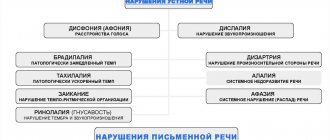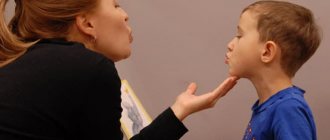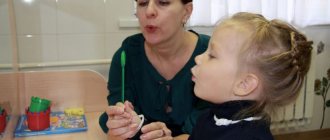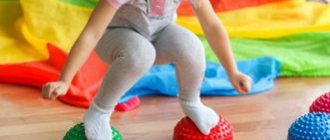Tags: Speech therapy, Speech development, Development
Methods and effective techniques for producing different sounds
When starting work on correcting sounds, you first need to determine the reason for their incorrect pronunciation. As a rule, disorders can occur with dyslalia, dysarthria, and rhinolalia. Each diagnosis has its own characteristics. However, no matter what type of disorder is diagnosed, it is important to know how sounds are characterized, what articulation should be, and what exercises are best to use for certain sounds.
Features of sound production
Work on correcting sound pronunciation begins with the sounds that are most accessible to the baby. All analyzers are used: vibration, auditory, visual and tactile. In the first lessons, you should not create completely new models of articulatory movements and phonemes in order to evoke the desired sound. Initially, the work is based on the maximum use of models available to the child.
Children diagnosed with reduced kinesthesia or phonemic hearing disorders are recommended to acquire intermediate articulations. The articulation itself can be improved by performing exercises to lengthen the exhalation and the required air flow pressure. Therefore, production of sounds usually begins in a lying position, developing lower-diaphragmatic breathing. This is how the child learns to smoothly inhale air through his nose and exhale it steadily through his mouth.
When working on the formation of articulatory praxis (the ability to pronounce a series of sounds of native speech), you need to take into account how strong the relationship between the muscles of the articulation organs is. It is useful to use the following techniques, which should be based on visual control (the child should control the exercise in the mirror):
- to move the tongue a little deeper in the mouth, push the corners of the mouth forward mechanically (for example, with your fingers);
- to move the tongue forward, the corners of the mouth are moved to the sides.
When correcting the pronunciation of sounds that the child distorts, you should not name them - this will cause their incorrect pronunciation.
Sounds are produced using the following methods:
- By imitation: for example, invite your child to roar like a tiger (rrr) or make the sound of a drill (drrr).
- By reference sounds: for example, we study sounds in this order - V-Z-Zh, M-B, N-D, S-SH-Z-ZH, F-V, F-S-SH.
- From the gymnastics of the language by sound, but use the correct diction - T, D, N. If the child pronounces sounds interdentally, then they should be taught to pronounce them correctly, and then put in defective sounds.
- Mechanical method (using a spatula, fingers, nipples, probes).
If you are working on correcting sound pronunciation, you should not forget about the following features:
- Parallel work on correct breathing and articulation is mandatory.
- The child must consciously control his own pronunciation by ear.
- The sounds being studied must be designated with special symbols.
- For older preschoolers, the letter designation of sounds is introduced, which promotes further literacy learning.
- Automation of sounds and their use in different conditions - in syllables, words and phrases, sentences.
- Prevention of dysgraphia.
Now that we've sorted out the theory a little, let's get down to practice.
Speech therapy classes and exercises: developing a child’s correct speech - read here.
Articulation gymnastics for children from 3 to 7 years old
Vocabulary development in preschool children: methods and techniques, here.
We put the sounds [L], [L']
To set the sounds [L], [L'], use the exercises “Needle”, “Painter”, “Turkey Poults”, “Steps”, “Ladle”, “Hunter”.
If the sound [L] is absent in the child’s speech, it is placed in 2 stages:
- Interdental production of sound, when the child is asked to say the combination of sounds “ya”. When pronouncing the sound “y”, you need to pronounce it briefly, straining the articulatory apparatus. Next, pronunciation is carried out by squeezing the tongue between clenched teeth. Repeat the exercise until the clarity of the sound is established - you need to establish the position of the jaw in which it was possible to reproduce the sound.
- Dental production of sound - the tongue is moved to a position behind the teeth, it is pressed firmly to the alveoli, and they pronounce “ly-ly-ly.”
It is important to develop the correct direction of the air stream. If a child has several sounds in interdental pronunciation, it is worth developing motor skills of the tip of the tongue. You can help with this in any convenient mechanical way.
If a child replaces the sound [L] with the sound [Y], he is asked to place a round tube on the middle part of the side of the tongue, with his mouth open, and the tip of the tongue should be tucked behind the upper incisors. The main difficulty is that the child continues to hear the sound that he played earlier. Therefore, it is important to connect the baby’s auditory attention to the sound that he pronounces during its production.
We put the sounds [P], [P']
The most common question encountered in practice is: “Why doesn’t he (she) say the sound “r”, are we worried?” And even though the baby is only 2 years old, parents begin to worry, having not understood the peculiarities of the formation of a range of sounds in children.
Getting the "R" sound right is a labor-intensive process. As practice shows, it is almost impossible to evoke it through imitation. Usually, its appearance in speech is preceded by a long preparation of the articulatory organs, the development of the necessary movements of the tongue, and learning to distinguish between correct and incorrect sounds.
The most suitable set of exercises is “Fast Snake”, “Woodpecker”, “Balalaika”, “Turkey Poult”, “Drummer”, “Ladle”, “Needle”. There are other equally effective exercises:
"Paint brush"
The baby smiles and opens his mouth slightly. Next, the child strokes the upper palate with his tongue back and forth, that is, from the front teeth towards the throat, retracting the tongue as deeply as possible. You need to repeat the exercise 10-12 times.
"Harmonic"
You need to smile and open your mouth, press your tongue to the roof of your mouth, as if you are preparing to utter a drawn-out “n” sound. Holding your tongue in this position, open your mouth as wide as possible, then close it. Repeat the exercise 15-20 times.
"Komarik"
Open your mouth, move the tip of your tongue behind your front teeth and try to pronounce the sound “z”. Then remove the tongue back, resting it on the upper palate at the line of growth of the front teeth. Say the sound “z” again.
Such exercises perfectly develop articulation, stretch the frenulum, and strengthen the facial muscles. But to make the sound [P], they also use special exercises:
- The child should open his mouth, press the tip of his tongue to the base of the front teeth near the roof of the mouth, while asking him to quickly pronounce the sound “d-d-d.” After a few seconds, ask your baby to blow strongly on the tip of his tongue, without stopping to pronounce the sound “d”. This exercise will help the child feel the desired vibration and remember it.
- The child opens his mouth wide and pronounces the sound “zh-zh-zh”, moving the tongue closer to the growth line of the upper teeth. After a couple of seconds, insert a special spatula under the child’s tongue and move it rhythmically to the sides, creating vibration. In this case, the child must blow forcefully on the pronounced sound, feeling the vibration and vibrations that result.
- Ask your child to make the sound "z-z-za" while pushing the tongue back as far as possible. Similar to the second exercise, insert the spatula under your tongue and move it left and right. If you do the training correctly, you will eventually hear a clear “R” sound.
- Similar to exercise No. 3, ask your baby to pronounce the sounds “z-zi” without closing his mouth. Make similar movements with a spatula. This exercise will allow you to make the sound “r”, but softer.
If the baby cannot keep his tongue up, and the sound itself turns out to be dull, ask him to lengthen the sound - drn-drn (for example, start the car).
Articulation gymnastics
It is best to perform all exercises in front of a mirror so that the child can see how he performs them. Each exercise is performed at least three times.
- “Window.” Pull your lips forward as much as possible and give them a square shape. Make sure that the corners of your lips do not touch each other.
- “Pancake.” Smile as widely as possible. Place your tongue on your lower lip, relax and count to 10. The tongue should stretch across the entire width of the lip, but you don’t need to reach it out too far, just enough to cover the lip.
- "Painter". Stretch your lips in a smile, open your mouth slightly, and reach your upper palate with your tongue. Make smooth movements, as if using a brush, from the teeth to the throat.
- “Brushing our teeth.” Smile and make movements with your tongue that imitate brushing your teeth. Be sure to ensure that your tongue reaches the gums and does not run along the bottom edge of the teeth.
- "Cup". Stretch your lips in a smile, stick out your tongue and reach your nose. Remain in position for up to 10 seconds.
- “Delicious food.” Open your mouth and lick your upper lip with your tongue. Movements should be made from top to bottom, not from side to side.
- "Air football" Pull out your lips with a tube. Blow on the cotton wool, but your cheeks should not swell. Blow for 10-15 seconds.
We recommend: Articulation gymnastics for the sounds Ш and Ж.
We put the sounds [Ш], [Х], [Ч]
Setting the sound "SH"
To put the child’s articulatory organs in the correct position in which he can pronounce the sound “Sh”, you can use a mechanical technique. To do this, we ask the child to pronounce the long sound “C” or the syllable “SA”. At this time, you need to carefully lift the tip of the tongue by the upper row of teeth onto the alveoli using a spatula or spoon. Thanks to such manipulations, the child will be able to pronounce the sound “SH”. But it’s too early to end this exercise: it is important to draw the child’s attention to his pronunciation of this sound. The adult’s task is to help the baby understand and remember this position of the articulatory organs.
When the child manages to pronounce the sound “Ш”, its automation begins. To do this, they practice the sound, combining it with vowels: SHA-SHU-SHI-SHE-ASHA-ISHI-USHU-OSHO, etc. Then they practice the sound in words, first of all using those where the sound “SH” is at the beginning, and only then those in which he occupies a place in the middle or end.
Next, the sound is practiced in sentences. To do this, tongue twisters or quatrains can be used, most words of which contain the sound “Ш”. At the last stage of sound production, you can invite the child to independently compose a story using reference words.
To form the sound “Ш” the following techniques are used:
- Imitation performance. Ask your child to lift his tongue towards his upper lip, forcefully but evenly, and let him exhale, controlling the flow of air with the back of his hand. As soon as warm air is felt, offer to move the tongue behind the upper teeth, touching the palate. The mouth should be slightly open, the lips should be slightly extended, the teeth should be a couple of millimeters apart. Invite your baby to exhale a stream of air - you will get the sound “SH”.
- Setting the sound “T” to the base. Ask your baby to pronounce the sound “T” every 2 seconds. Then ask him to make his tongue hit the alveoli rather than the teeth. Gradually, the sonorous “T” will turn into a more hissing sound. Next, ask the child to round his lips and pull them forward, and lift his tongue up towards the palate (towards the front). The sides of the tongue should be pressed against the molars. Now, pronouncing the sound “T”, the child will be able to smoothly move on to pronouncing the sound “SH”.
- Based on the sound "S". Offer to move the tongue behind the lower teeth and pronounce the sound “C”. At the same time, use a spatula to lift the tongue up, let the child continue to pronounce the sound “C”. Using your fingers, lightly press on the cheeks so that the lips move forward. You should hear a hissing sound. To consolidate the result, ask your child to pronounce the syllables “SA”, “SI”, “SO”, “SY”, “SU”, “AS”, etc.
During classes, do not forget to use exercises that contribute to the general strengthening and development of the articulatory apparatus.
Making the sound “Zh”
The sound “Zh” is placed by analogy with the sound “Sh”. The only difference is that in this case we add voice sound. Articulation during production should be as follows:
- the lips are rounded and slightly moved forward;
- the teeth are close together, but not closed;
- the wide tip of the tongue is brought closer to the upper palate or alveoli, forming a gap between them; lower the middle of the tongue, pressing its edges to the side teeth; lift the back of the tongue and pull it back;
- a warm stream of air should pass through the middle of the tongue, which can be felt with the palm of your hand;
- the soft palate is lifted, pressing it to the pharynx, to its back wall, closing the passage into the nasopharynx, a stream of air exits through the mouth;
- The vocal folds need to be tensed and a voice must be produced.
As exercises, you can use imitation games (“Say what a bee says,” “...how a plane flies,” “...how a beetle buzzes,” etc.), tongue twisters, identifying sounds in words, and others.
Setting the sound "Ch"
When pronouncing the sound “Ch,” the child is asked to slightly round his lips, making a tube, and move them a little forward. There is no need to close your teeth, but they should be close to each other. The back and tip of the tongue should connect to the alveoli or upper teeth, forming a gap. When trying to pronounce the sound “Ch”, the child should feel a short stream of air passing through the middle of the tongue. The soft palate remains raised and pressed to the back of the pharynx. The vocal cords should not strain.
The sound “Ch” is made on the basis of “Ть” and “Ш”. Therefore, speech therapists use 2 methods of setting “H”:
- Ask your baby to pronounce the sound “TH” often and quickly (the tip of the tongue should touch the base of the upper teeth). Then the baby should gradually move his tongue back, touching the upper alveoli with it. In the process, the lips should stretch into a smile.
- Ask the child to first slowly and then quickly pronounce the sounds “TH” and “SH”, so that in the end it comes out TSH. Make sure that the child has a wide smile during the pronunciation process.
Automation of sound is performed in a playful way that is interesting for the child. Be sure to take into account the age of the baby when choosing activities and exercises. Don't neglect bright visual material.
Correct articulation
The exercises described above clearly demonstrate that the production of the sound [H] is possible in several ways, which differ in the method of sound production:
1. Use of a reference sound and correct placement of successive movements of the tongue:
- The baby is asked to always pronounce soft [t'] and at the same time concentrate on ensuring that the tongue is tightly adjacent to the alveoli. Then the specialist shows how to curl the tongue towards the larynx from this position. A spatula is used for this. If the isolated sound [t'] is difficult for him, you can replace it with [at'];
- the child is asked to say [t'] and at the same time press the corners of his mouth with his fingers, stretching his lips out like a tube. With this position of the lips, the tongue automatically slides back.
2. Using the effect of merging parts [H]:
- you need to ask the baby to consistently but quickly pronounce the hard voiceless [t], followed by [sch]. At first this is done slowly, and then with increasing tempo of acceleration. It is important that the pronunciation is formed while exhaling.
3. Exercise using a playful form of imitation:
- imitate the chirping of a grasshopper or “call” ducks – “kacha-kacha”;
- read poetry to the child: the adult reads the lines and pauses in those places where the child should utter a sound.
4. Use reference sounds:
- ask to pronounce the sound “t”, focusing on the correct position of the tongue. As the child pronounces, accompany the sound formation with the movement of a bending palm.
It is difficult for a non-specialist to determine which method is suitable for a child. To do this, parents can alternately use each of these exercises. Based on the results of the work, its effectiveness is assessed. The main thing is not to stop at the fact that the child can differentiate the sounds [t'] and [h], because the articulatory skill has not yet been consolidated.
We put the sounds [K], [G], [X]
The sound “K” is made mechanically using a spatula. The articulation looks like this:
- the lips should take the position of the next vowel sound;
- You can’t keep your teeth closed;
- the tip of the tongue needs to be lowered and touched with it to the incisors of the lower dentition;
- the lateral parts of the tongue are adjacent to the upper lateral teeth;
- the back of the tongue should form a bow with the palate;
- the soft palate rises at this time, blocking the passage to the nasopharynx;
- there is no need to strain the vocal cords, they are open;
- During exhalation, the resulting stream of air should explode the bow, causing a characteristic sound.
The first version of the production is from the sound “T”. It is used if the child pronounces the sound “T” clearly, cleanly, without unnecessary overtones.
Invite your baby to play the sound “TA”. At the same time, press the spatula on the front part of the back of the tongue, as a result of which the sound “TY” will be heard. Next, you need to move the spatula a little further into the depth, which will provoke the pronunciation of the sound “KY”. Even deeper pressure on the tongue gives a clear pronunciation of the sound “KA”. The use of the mechanical method is stopped when the child remembers the location of the articulatory organs for pronunciation of the sound being studied.
The sound “K” can be made while inhaling. This exercise is reminiscent of imitation snoring - silent or whispering. Encourage your child to snore for fun. After the exercise, you can hear a sound reminiscent of “K”. Invite your child to say “KA” while inhaling and exhaling. After this, automate the sound traditionally: “KA-KO-KU-KI-KE-KYO.”
The articulation of the sound “G” is similar to the articulation of the sound “K”. However, the voice is involved in this process - the vocal cords must close and vibrate during exercise.
The sound "G" can be placed from "Y". To do this, invite the child to throw his head back and, while exhaling strongly, say “YYYYY”, simultaneously pushing his lower jaw forward, raising it and lowering it. By analogy with the production of the sound “K” from “TA”, you can place the sound “G” from “DA”.
The articulation of the sound “X” differs from “K” in that the back of the back of the tongue should form not a bow with the palate, but a gap along the midline. The sound “X” can be made like this: invite the child to open his mouth the width of two fingers and blow warm air on his palms. If the sound does not work, you can try throwing your head up in the process. The sound “X” can be placed from “S” and “Sh”. They use a mechanical method: when the child pronounces these sounds, you need to use a spatula to move the tongue deeper into the mouth.
Exercises to develop exhalation
- The baby stands with his feet shoulder-width apart. While inhaling, he spreads his arms with his nose, while exhaling, he squats and hugs himself with his arms.
- Starting position is the same as in the previous exercise. Connect your hands in a “lock”, they are at the bottom. As you inhale, your arms rise up, while your breath is held. Then exhale very slowly, lowering your hands and saying “uh.”
- Puff out your cheeks to the maximum, hold for half a minute. Then pull your cheeks in and hold again for the same amount of time.
- Sit on a chair. Slowly lower and raise your hands, saying “Kaar”.
- Game-competition. Children compete to see who can growl the longest in one breath. (You can also compete to see who can hum the longest while exhaling.)
Set the sound [Y]
Most often, the sound “Y” can be produced by imitation, supplementing the exercises with showing correct articulation and the tactile sensation of the expiratory stream when pronouncing “YYYY” in a drawn-out manner.
They make a sound from pronouncing the sounds “AIA” or “IA”. The exhalation must be intensified when the sound “I” is pronounced, and the short “A” must be pronounced without interruption. Sometimes placing the “Y” sound in words where it comes first is effective.
From the syllable “ЗЯ” the sound is made mechanically: the child pronounces the syllable, and the adult, using a spatula, presses on the front part of the back of the tongue, gradually moving it back until the desired sound is obtained.
Set the sound [C]
The articulation is as follows:
- lips are in a neutral position;
- teeth are brought closer by 1-2 mm;
- the tip of the tongue is lowered, touching the lower incisors; Initially, the back of the tongue is strongly curved, forming a bow with the incisors, then its front part quickly moves to the position of the “C” sound, forming a groove in the middle;
- the air stream should be strong and uneven.
The sound “C” is produced if the child clearly pronounces the sounds “S” and “T”. The baby is asked to quickly pronounce “TS”, as a result of which the desired sound appears.
There are 3 ways to make the sound “C”:
- Method of imitation using play techniques (“The locomotive, stopping, says - tss-ts-ts”, “The mouse is sleeping, don’t make noise - tss-ts-ts!”).
- Reception of reference sounds (in this case these are “T” and “S”).
- Acceptance of the features of articulatory structure. Invite the child to open his mouth, rest the tip of his tongue against the incisors of the lower row of teeth, lift the tongue and stretch it so that its front part is pressed against the palate. In this position, the back of the tongue should touch the upper incisors. Without turning on your voice, invite your baby to pronounce the sound “T”, lifting the tip of the tongue with the pressure of a stream of air from the front teeth of the lower row. The lips should be tense and in a smiling position. This exercise helps to remember the position of the organs of articulation when the sound “C” is pronounced.
Lip exercises
- “Grimaces of a Clown.” Keep your lips smiling. In this case, the lips should be tense, and the teeth should not be visible. The duration of the exercise is 15 seconds.
- “Fence.” Smile again, but at the same time close your teeth and expose them. Hold the position for 10 seconds.
- “Tube”. Pull your lips into a tube and hold for a third of a minute. The teeth don't connect.
- "Bagel". Round your lips and pull them forward slightly. Hold in position for 15 seconds.
To achieve good articulation, exercises need to be alternated, changing the sequence each time.
Sound setting [C]
The articulation of “C” is as follows:
- lips need to be stretched into a weak smile;
- bring your teeth closer, but do not close them;
- lean the tip of the tongue against the front teeth of the lower row, arch the tongue, resting its sides on the molars;
- create a strong and narrow air stream.
Before starting sound production, you should make sure that the child’s articulatory apparatus is ready to pronounce whistling sounds. For preparation, a set of special speech therapy exercises is used to improve the articulatory apparatus.
The sound “C” is placed in several ways:
- By imitation. Sitting with your child in front of the mirror, show how to pronounce the sound “C”.
- By imitation with game moments. For this method, visual aids and bright objects are used, with which you can imitate the sound “C”. For example, the balloon deflates - “SSSS”.
- Based on reference sounds. To learn to pronounce the sound “S”, a child must be able to pronounce the sounds “I” and “F”, which are the reference sounds for him.
- Mechanical setting. Using a spatula, the speech therapist sets the child’s tongue in the desired position and asks to gently but forcefully blow out the air.
The main thing is to give the child the opportunity to remember the position of the articulatory organs when playing the sound “C”, only then can it be automated in syllables, words and sentences.
Differentiation of sounds [h]-[t], [h]-[ts], [h]-[sch]
The easiest, but at the same time effective exercise.
Pronounce the following syllables in turn:
| tsa-cha-sha-ta | tso - what - what - that | tsu - chu - schu - tu |
| tsy - chi - cabbage soup - ti | tse -che - more - those | sha - cha - tsa - ta |
| what - what - so - then | schu - chu - tsu - tu | cabbage soup - chi - tsy - you |
| shche-che-tse-those | ats - ach - ash - at | ots - och - oshch - from |
| uts - uch - ush - ut | yats - yach - box - yat | its - ich - isch - it |
| ec - ech - yet - et | ash - ach - ats - at | oshch - och - ots - from |
| ush - uch - uts - ut | box - yach - yats - yat | isch -ich -its -it |
| yet - ech - ec - ut |
Set the sound to [Z]
The articulation when producing the sound “Z” is similar to “S”, only the sound “Z” is more sonorous, so you need to use your voice when pronouncing it. The sound “Z” is placed after successful automation of “S”.
Setting “Z” is similar to working with the sound “S”, only you need to make sure that the child connects his voice and feels the vibration of the ligaments. It is very important to be able to convey to the child that these sounds differ in their sound. To do this, invite your baby to put his hand on his throat and pronounce both sounds alternately. The child will understand this difference by vibration. When the sound “Z” is heard clearly, invite the child to pronounce it louder and clearer. After this, automate the sound through exercises on pronouncing syllables, words, and sentences.
Sound automation [h]
To automate pronunciation, the following sequence of exercises is used:
- first pronouncing direct and then reverse syllables: cha-ach, uch-chu, cho-och;
- pronouncing one- and two-syllable words with [h] at the end: ball, game, bulls, bird;
- pronunciation of words where the sound is in the middle: barrel, duck, spiders;
- pronouncing words that begin with [h]: teapot, cast iron, Chukotka;
- reading or pronouncing phrases with sound, pairing them: tea cups, leather suitcase, stump-stump, cat-cat.
- pure phrases and poems saturated with this sound are the final part of speech therapy work on automation.
Automation of the sound [h] in straight syllables
Automation of the sound [h] in reverse syllables
Automation of sound [h] in words
Automation of sound [h] in phrases and sentences
Automation of sound [h] in pure language
Automation of sound [h] in poems
How to correctly produce sounds in a child: general recommendations
The child’s efforts should be natural - this is very important in producing sounds. The sequence of production is determined by the physiological course of formation of the pronunciation of sounds. Changes and adjustments can be made to this sequence if the individual characteristics of the child are taken into account and there is confidence in their effectiveness.
The standard sequence of working on sounds looks like this:
- First they put the whistling “S” and “Сь”, “Ц”, “З” and “Зь”.
- They put “SH” - a hissing sound.
- Sonor "L".
- They disassemble “Zh” - hissing.
- Sonoras "P" and "Pb".
- They end with the production of hissing “Ch” and “Shch”.
The optimal age for correcting sound pronunciation is considered to be 4-5 years, for the sound “R” - 6 years of age. Work usually begins on hissing sounds, since they do not require clear focusing of the air stream.
To place hard sounds, use the vowel “A” for the syllable (for “L” - “Y”), for soft sounds - “I”. Automation of the sound that has been corrected begins with the pronunciation of forward and backward syllables, only then with a combination of consonants.
In general, work on sound production should be carried out by a speech therapist. He will determine whether the child has deviations in sound pronunciation, what methods to use to produce sounds, how often to practice, he will draw up a lesson plan that will include various, most effective in this case, techniques. Remember that amateur efforts to correct problems with sound pronunciation in children can be harmful. Only a speech therapist knows how to organize work correctly and effectively.

